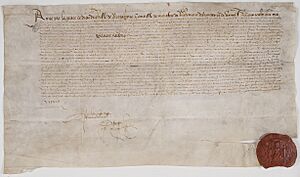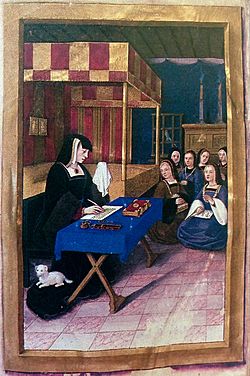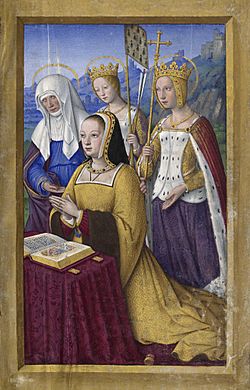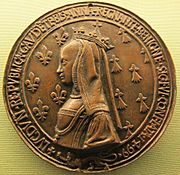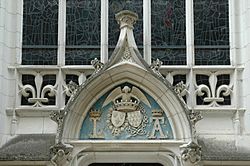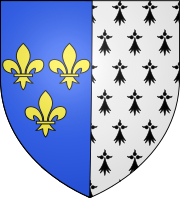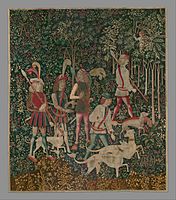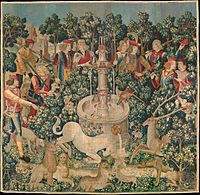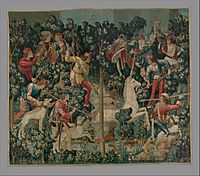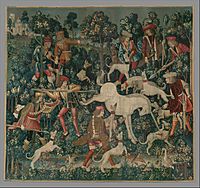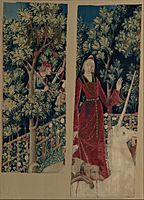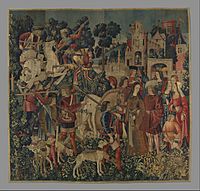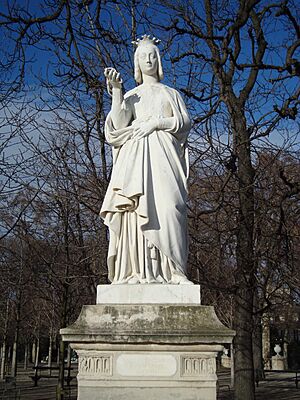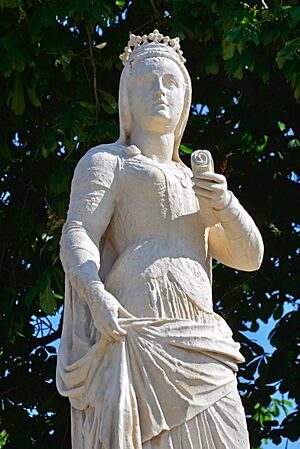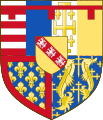Anne of Brittany facts for kids
Quick facts for kids Anne |
|
|---|---|
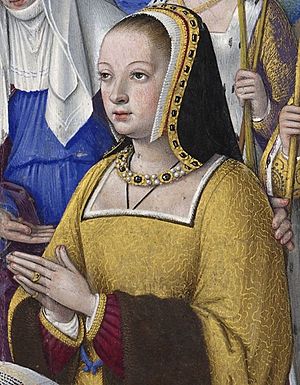
Miniature depiction in the Great Hours of Anne of Brittany, by Jean Bourdichon (c. 1503-1508)
|
|
| Duchess of Brittany | |
| Reign | 9 September 1488 – 9 January 1514 |
| Enthronement | 10 February 1489 |
| Predecessor | Francis II |
| Successor | Claude |
| Queen consort of Germany | |
| Tenure | 19 December 1490 – 15 February 1492 |
| Queen consort of France | |
| Tenure | 6 December 1491 – 7 April 1498 |
| Coronation | 8 February 1492 |
| Tenure | 8 January 1499 – 9 January 1514 |
| Coronation | 18 November 1504 |
| Queen consort of Naples | |
| Tenure | 2 August 1501 – 31 January 1504 |
| Born | 25/26 January 1477 Nantes, Brittany |
| Died | 9 January 1514 (aged 36) Blois, France |
| Burial | 15 February 1514 Saint Denis Basilica |
| Spouse |
|
| Issue among others... |
|
| House | Dreux-Montfort |
| Father | Francis II, Duke of Brittany |
| Mother | Margaret of Foix |
Anne of Brittany (born January 25 or 26, 1477 – died January 9, 1514) was a very important ruler in French history. She was the Duchess of Brittany in her own right from 1488 until she died. She also became Queen of France twice. First, she was queen from 1491 to 1498, and then again from 1499 until her death. She was the only woman to be queen of France two times. Anne was known for protecting Brittany's independence.
Anne grew up in Nantes during a time when the King of France wanted to control Brittany. Her father, Francis II, Duke of Brittany, was the last male ruler of his family line. When he died in 1488, Anne became the Duchess of Brittany. She was only 11 years old. Brittany was a very important place because of its location. This made Anne a highly sought-after bride. The next year, she married Maximilian I of Austria by proxy. This meant someone stood in for him at the wedding. But Charles VIII of France saw this as a threat. He started a war that forced Anne to end her marriage to Maximilian.
Anne then married Charles VIII in 1491. Sadly, none of their children lived past early childhood. When Charles VIII died in 1498, his cousin, Louis XII, became king. To make sure Brittany stayed connected to France, Anne had to marry the new king. Anne and Louis XII had two daughters. Neither daughter could become Queen of France because of a law called the Salic Law. However, their older daughter was named the heir to Brittany. Anne wanted her older daughter to marry Charles of Austria. But after Anne died in 1514, her daughter married her cousin, Francis I of France. This marriage eventually led to Brittany becoming a permanent part of France.
Anne was highly respected in Brittany. She was seen as a strong ruler who protected her duchy from France. Later, she became a symbol of Breton pride. Many statues and memorials honor her. She also supported artists and helped with building projects in castles like Blois and Amboise.
Contents
Anne's Life Story
Growing Up and Learning
Anne was born on January 25 or 26, 1477. Her birthplace was the Castle of the Dukes of Brittany in Nantes. She was the first child of Duke Francis II of Brittany and his wife, Margaret of Foix. Four years later, her sister Isabelle was born. Anne's mother died when Anne was very young. Her father passed away when Anne was eleven.
Anne likely learned to read and write in French. She might have also learned a little Latin. It is not true that she learned Greek or Hebrew. She also did not speak or understand the Breton language. Her governess, Françoise de Dinan, helped raise her. She also had tutors, including a poet named Jean Meschinot. He taught her dancing, singing, and music.
Becoming Duchess of Brittany
At that time, the rules for who would inherit the throne were not clear. Women could usually inherit only if there were no male heirs left. However, a special agreement from 1365 said that if the male line of Anne's family died out, another family would inherit Brittany. By the time Anne was born, her father was the only male left in his family line.
To prevent Brittany from being taken over by France, her father, Francis II, had Anne officially recognized as his heir. This happened on February 10, 1486. But the question of who she would marry remained a big issue.
Marriage Plans
As the main heir to Brittany, Anne was a key part of her father's plans. Francis II promised his daughter to different princes. He did this to get military and financial help. This also helped him strengthen his position against the King of France. These marriage talks allowed the Duke to make secret alliances. Anne became very important in these plans. Her father could refuse some marriage offers because of these alliances.
Anne was engaged to several European princes:
- In 1480, she was promised to Edward, Prince of Wales. He was the son of the King of England. But he disappeared after his father died in 1483.
- Maximilian, King of the Romans, was another important suitor. He was a powerful ruler from Austria.
- Alain I of Albret wanted to marry Anne. He was a distant relative and a possible heir to Brittany. But Anne refused him because she did not like him. She said she only considered it out of obedience to her father.
- Louis, Duke of Orléans, a cousin of the French King, also wanted to marry her. He was already married, but he hoped to get an annulment.
Her Marriages
In 1488, Anne's father was defeated in a war against France. This war was called the Mad War. In the peace treaty, her father had to agree that Anne could not marry without the French King's approval.
Soon after, her father died from a fall. Brittany faced a new crisis. On his deathbed, her father made Anne promise never to let Brittany be taken over by France. He also named a guardian for her, Marshal Rieux.
Anne was crowned Duchess of Brittany in Rennes on February 10, 1489. She was only 13 years old. On December 19, 1490, she married Maximilian I of Austria by proxy. This made her the Queen of the Romans. The French saw this as a serious problem. It went against the treaty and brought an enemy ruler to Brittany. Maximilian's family was too busy with other issues to help Brittany.
Spain and England sent small groups of soldiers to help Brittany. But neither wanted a full war with France. In 1491, the French army, led by La Trémoille, had more success. King Charles VIII of France then surrounded Rennes, where Anne was staying. He wanted to force her to end her marriage to Maximilian. Rennes held out for two months. During this time, Anne's sister Isabelle died.
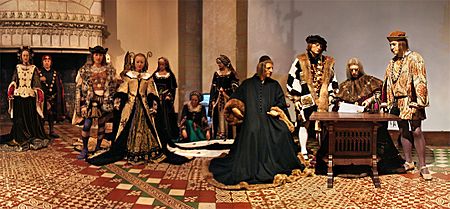
Charles VIII entered Rennes on November 15. Anne signed a treaty with him. After refusing other French princes, Anne became engaged to King Charles VIII on November 17, 1491. She then traveled to Langeais to be married. Austria protested, saying the marriage was illegal. They said Anne was already married to Maximilian and Charles VIII was engaged to Maximilian's daughter.
The official wedding between Anne and King Charles VIII of France happened on December 6, 1491. It was a quiet and urgent ceremony. The marriage was technically illegal until the Pope approved it. Pope Innocent VIII annulled Anne's proxy marriage to Maximilian. He also allowed her to marry Charles VIII. This was needed because they were related. The marriage contract said that the person who lived longer would keep Brittany. But it also said if Charles VIII died without male heirs, Anne would marry his successor. This gave France another chance to take over Brittany.
Queen of France
After marrying Charles VIII in 1491, Anne became Queen of France. Their marriage contract was meant to bring peace between Brittany and France. Anne was crowned Queen of France on February 8, 1492. This happened at St. Denis Basilica. She was the first queen crowned there. Her husband did not want her to use the title Duchess of Brittany. This caused some arguments between them.
Anne's marriage started with difficulties. She and Charles often lived apart. Despite this, she was pregnant for most of her married life. When her husband was fighting in Italy, his sister, Anne of Beaujeu, ruled France. Anne of Brittany had a small role in France and Brittany. She sometimes had to be separated from her young children. She mostly lived in royal castles like Amboise and Blois.
Duchess of Brittany and Second Marriage
When Charles VIII died in an accident on April 4, 1498, Anne was 21 years old. She had no living children. She then took control of Brittany herself. She brought back loyal advisors. She also ordered a gold coin with her name on it.
Anne had a famous group of poets and writers around her. She also hired the best musicians of her time. Anne of Brittany was one of the first Queens of France to be a major supporter of artists and writers.
Three days after her husband's death, her marriage contract came into effect. This meant she had to marry the new king, Louis XII. However, Louis XII was already married to Joan. On August 19, 1498, Anne agreed to marry Louis XII if he could get his first marriage annulled within a year. Anne then returned to Brittany in October 1498.
Anne might have hoped the annulment would not happen. But Louis's first marriage was ended by the Pope before the year was over. Anne's third marriage contract was signed on January 7, 1499. This time, Anne was not a child. She was a Dowager Queen. She was determined to make sure her rights as Duchess of Brittany were recognized. Her new husband, Louis XII, agreed to recognize her as "Duchess of Brittany." He also agreed that their second child, boy or girl, would inherit Brittany. This was meant to keep Brittany separate from France. However, this part of the agreement was not followed later. Anne's second coronation as Queen happened on November 18, 1504.
Anne mostly lived at the Château de Blois. She built the tomb for her parents at Nantes Cathedral. Her heart would later be placed there. She loved Italian art.
As Duchess, Anne strongly defended Brittany's independence. She planned for her daughter, Claude, to marry Charles of Austria. This marriage would have strengthened the alliance between France and Spain. Louis XII publicly agreed to this plan. But secretly, he wanted Claude to marry the heir to the French throne, Francis of Angoulême. Anne refused to agree to this marriage until her death. She wanted Claude to marry Charles, or for her other daughter, Renée, to inherit Brittany. When Louis XII went against her wishes for their daughters, Anne left him. She toured Brittany, visiting many places she had never seen. This was a political trip to show her power as Duchess. Letters show how much Louis missed her. He asked about her return many times a day. From June to September 1505, she was welcomed grandly in many cities in Brittany. She also made sure taxes were collected properly.
Her Death
Anne had many pregnancies and miscarriages. She died from a kidney stone attack on January 9, 1514, at the Château de Blois. She was 36 years old. In her will, she asked for her body to be divided. Her heart, organs, and bones would be buried in different places. This was a special tradition for royal families.
Anne's will also said that her second daughter, Renée, should inherit Brittany. But her husband, Louis XII, ignored this. He made Claude the Duchess. He put Claude under the care of Anne's rival, Louise of Savoy. He then married Claude to Francis, Louise's son, the year after Anne died. When Francis became king in 1515, Brittany became part of the French queen's property again.
Anne was buried in the royal burial place of Saint Denis. Her funeral was very long, lasting 40 days. It set the standard for all future French royal funerals. During the funeral, the Herald of Arms of Brittany said the traditional words: La reine est morte!, la reine est morte!, la reine est morte! (The Queen is dead!, The Queen is dead!, The Queen is dead!).
According to her will, Anne's heart was placed in a special gold box. This box was then taken to Nantes. It was placed in her parents' tomb. This happened on March 19, 1514. The heart was later moved to the Saint-Pierre Cathedral. The heart reliquary is an oval box made of gold. It has a special braided design and a crown of lilies. It has an inscription that says:
- In this small vessel
- Of pure and fine gold
- Rests a greater heart
- Than any lady ever had in the world
- Anne was her name
- Twice Queen in France
- Duchess of the Bretons
- Royal and Sovereign.
This beautiful box was made by an unknown goldsmith from the court of Blois. In 1792, during the French Revolution, the box was taken and emptied. It was sent to Paris to be melted down. But it was saved and kept in the National Library. It was returned to Nantes in 1819. It is now in the Dobrée Museum. In 2018, it was stolen but later found undamaged.
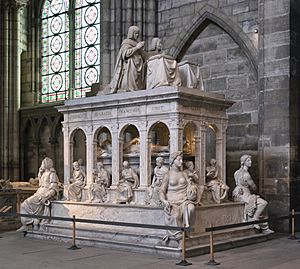
The large tomb of Louis XII and Anne of Brittany was carved from marble. It was revealed at Saint Denis Basilica in 1531. The tomb shows scenes of Louis XII's victories. It also has statues of the Twelve Apostles and four virtues. Italian sculptors created it. During the Revolution, the tomb was damaged, and the bodies were removed. But much of the monument was saved. It was later returned to the Basilica.
Anne's Character and Interests
Anne was a very smart woman. She spent a lot of time managing Brittany. People described her as clever, proud, and sometimes stubborn. Her main goal was to protect Brittany's independence. She wanted it to remain separate from the French crown. Although this goal was not fully achieved after her death.
Anne also loved the arts and music. She collected many tapestries. It is believed that the famous unicorn tapestries were made for her wedding to Louis XII. Her most famous illuminated manuscript is the Grandes Heures of Anne of Brittany. She also supported authors and printed books.
She was a loving mother. She spent as much time as possible with her children. She ordered a prayer book for her son, Charles-Orland. This was to teach him how to pray and prepare him to be king. Sadly, Charles-Orland died in 1495. No other sons lived long. She also ordered a learning book for her 8-year-old daughter, Claude. This book showed Anne's coat of arms. It was meant to pass on values from mother to daughter, and from queen to queen. Claude later ordered a similar book for her younger sister, Renée. These books show what was important in the princesses' education.
Anne made her royal household much larger. She especially welcomed young girls, creating a kind of finishing school. She also had 100 Breton gentlemen at court. These ideas influenced later French royal courts.
Anne had a slight limp because one leg was shorter than the other. She wore special shoes to help her walk smoothly. She passed this trait on to her daughter, Claude.
Her Children
With Charles VIII of France, Anne had one child who lived for a few years:
- Charles Orland, Dauphin of France (born October 11, 1492 – died December 16, 1495). He died of measles when he was three years old.
With Louis XII of France, she had two daughters who lived past childhood:
- Claude of France (born October 13, 1499 – died July 20, 1524). She became Duchess of Brittany after Anne. She later became Queen of France when she married Francis I.
- Renée of France (born October 25, 1510 – died June 12, 1574). She married Ercole II d'Este, the Duke of Ferrara.
Anne of Brittany is an ancestor of many European royal families through her daughters.
Emblems and Mottos
Anne inherited symbols from earlier Breton rulers. These included the ermine (a type of stoat) and a special cord. After her first husband, Charles VIII, died, she started the Order of the Ladies of the Cord in 1498. This was inspired by her father.
As her own symbol, she used a crowned letter "A." Her motto was Non mudera, which means "I will not change." She also used a special knotted cord, like her father's. Her symbols were often combined with those of her husbands in castles and books. Charles VIII's symbol was a flaming sword, and Louis XII's was a porcupine. She also used the motto Potius Mori Quam Foedari, meaning "Rather die than dishonor." In Breton, this is "Kentoc'h mervel eget bezañ saotret."
You can find these symbols in many places connected to her:
- On the tomb at Solesmes Abbey.
- In stained glass windows at churches like Ervy-le-Châtel.
- In stained glass at the town hall of Étampes.
The Hunt of the Unicorn Tapestries
Some people believe that the famous tapestries called "The Hunt of the Unicorn" are connected to her marriage to King Louis XII. This is not proven, but it is an interesting idea.
Gallery
How Anne is Remembered
Even when she was alive, the kings she married used her image to show peace and unity between France and Brittany. People often called her the "Good Duchess." In later centuries, historians and popular culture have shown Anne in different ways. They sometimes gave her traits that are not always supported by facts.
After her death, she was mostly forgotten until the mid-1800s. Then, a group called the Breton Association started to look for a figure to represent their region. They chose Anne of Brittany. This is where the idea of the "Duchess in clogs" comes from, showing her as a simple, patriotic figure.
Many stories and myths now surround Anne of Brittany. Some see her as a woman forced into marriage. Others see her as a duchess dedicated to Brittany's freedom. Still others see her as a queen who brought peace between Brittany and France. These different views show how people interpret history.
This is why many books have been written about Anne. Some describe her as "limited, petty, and vengeful." Others say she had a "rich and favorable personality," and was "ardently attached to her country and people."
Images for kids
See also
 In Spanish: Ana de Bretaña para niños
In Spanish: Ana de Bretaña para niños


